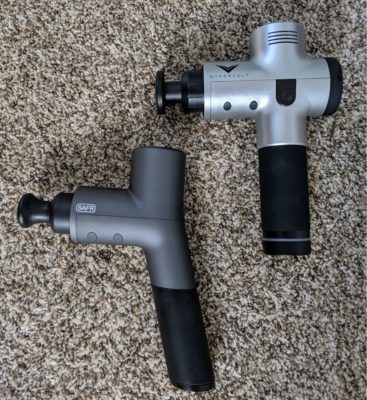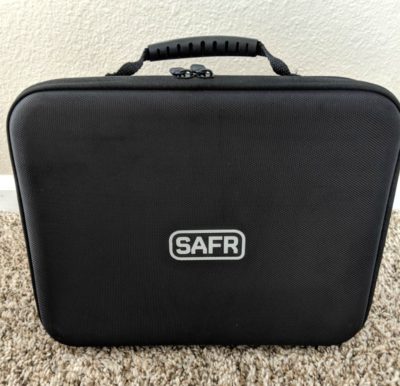Today, for a little something different, I’m publishing a review of a new percussive massage tool that aims to help with muscle recovery. You may have heard about the Theragun, a handheld tool that serves to give you a deep tissue massage without having to go to a masseuse. I’ve read some articles praising its benefits, but didn’t pay too close attention until my good friend Sarah bought the Hypervolt – a cheaper version of the Theragun. She’s been raving about it ever since, and after trying it, I can see why – it’s much more intense than a regular electric massager, so much that several of my friends couldn’t even handle it on the highest setting.
While the original Theragun percussive massage tool is an eye-popping $599, the Hypervolt is still pretty pricey at $349 – and I couldn’t stomach that price point. I set an alert on Slickdeals for sales on either the Theragun or Hypervolt, and a few weeks ago, got notified that there was a discount plus stackable coupon at Dick’s that made the Hypervolt $279 – the best price anyone’s ever seen. I decided to pull the trigger and buy it, but also picked up an off-brand option, the SAFR X1, which was on sale at Amazon for only $149. Let the comparison begin!
Size and Design
While the Theragun has a triangular handle design, both the Hypervolt and the SAFR X1 look more like a gun – a long handle down where you turn the power on / off and adjust the speed, and a crossbar where the pulsing attachment goes. The Hypervolt has both the shaft and the crossbar completely straight; the X1’s shaft has a bit of an angled swoop to it. I’ve seen some commenters online say the X1 is more ergonomic, but as I don’t intend to use either one for hours and hours in the exact same position, I’d consider them to be about the same.

I weighed both tools on my kitchen scale with no attachments on. The X1 clocked in at 2 lbs 1 oz, the Hypervolt weighed 2 lbs 5 oz. A few ounces isn’t a big difference, but the X1 does have a bit of an edge here. Both tools feel well-made and substantial, not at all cheap. And while one Amazon reviewer said that their X1 had a chemical smell / off-gassing, I didn’t notice this issue at all.
Winner: SAFR X1
Attachments
The Hypervolt comes with five attachments: a ball, a flat (looks like a flat head screw), a cushion (kind of a hybrid of the ball and flat), a bullet, and a fork. The ball, flat, and cushion are intended to be for full body use; the bullet and the fork are supposed to be for trigger points and smaller areas. Here’s a video from Hypervolt on the attachments and how they work.
The SAFR X1 comes with four attachments that are essentially the same as the Hypervolt’s offering; it just doesn’t offer the cushion (which was my least favorite anyway). However, I found that the Hypervolt’s flat was much more aggressive than the X1’s because the edges didn’t taper, which I preferred. I felt like the X1’s rounded edges on the flat softened the impact a bit, whereas I like my massages as hard as possible. This was a pretty minor complaint, though, and if I didn’t have them to compare side by side, I’d find the X1’s flat attachment just fine.


The big difference with the attachments, though, was how they actually attach. The X1 requires you to push the attachment in pretty hard while also turning it in, like a screw. (I didn’t realize this until after I had an attachment slide out once I turned the percussion on, and then I read the limited instruction book.) It took me a few tries to fully get the hang of how much to push in while turning, to ensure that the attachment is fully in. The Hypervolt, on the other hand, allows you to just casually push the attachment in with no need for twisting, and seems to lock pretty automatically. I wouldn’t say it’s overly difficult to put the attachments on the X1, but it requires a little bit of extra awareness, while the Hypervolt is more intuitive – when you push an attachment on, it’s on.
Winner: Hypervolt
Function
The Hypervolt has three speed settings: 2,000 percussions per minute (PPM), 2,600 PPM, and 3,200 PPM. The SAFR X1 has five settings: 1,400 PPM, 1,800 PPM, 2,200 PPM, 2,600 PPM, and 3,200 PPM. Honestly, I tend to use both at their top speeds most of the time anyway, but it was nice to have some options – especially when dealing with a really tender area. I don’t have a way to verify this, but the X1’s top settings seemed faster than the Hypervolt; before I looked at the actual numbers provided by each manufacturer, I would have thought the X1’s top settings had higher PPMs than the Hypervolt.
The Hypervolt also requires you to flip a switch on the bottom to turn the device on, then press a button to actually start the percussion. More than once, I finished using they Hypervolt and pressed the button to turn the percussion off, but forgot to flip the switch on the bottom, which caused the battery to run down even though I wasn’t using it. I don’t understand why the Hypervolt has two separate on/off switches rather than just one, like the X1 – it’s not very intuitive.
Winner: SAFR X1
Noise
The cheapest option of all for a percussive massage tool is the DIY option – there are tutorials online that will show you how to convert a $50 jigsaw like you’d buy at Home Depot into a percussive massager, with a kit like this. However, this option was reportedly much louder than buying one of the purpose-made tools. (Plus, since I want to be able to travel with my massage tool, I was worried about getting a janky DIY jigsaw through airport security.) According to other reviews, the Hypervolt is reportedly even quieter than the Theragun, but how would the SAFR X1 stack up? Pretty similarly. To my ears, the X1 was just barely noticeably louder than the Hypervolt, but not significantly so where it would actually be an issue.
To find out for sure, though, I downloaded a decibel meter app on my phone and put both devices through their paces, using the flat attachment on both. As I already mentioned, the Hypervolt operates at three speeds, and clocked in at 40 db, 44 db, and 51 db as I increased the speed. The X1 operates at five speeds, and clocked in at 40 db, 44 db, 46 db, 51 db, and 56 db. (Their website claims the X1 operates at 55db, which I’d say is fair given that most people will probably operate in the higher range.) In all, the X1 was definitely a little bit louder for the same speeds, but even the high of 56 decibels is labeled by my decibel meter as being a “quiet office” – so it’s by no means disruptive. I had no problem watching TV or holding a conversation while using either of these devices.
Winner: Hypervolt
Price
While the Hypervolt and the SAFR X1 have been pretty similar in most of the categories I’ve covered, price is where the X1 absolutely soars. The Hypervolt is regularly priced at $349; the X1 is only $199. Sales on the Hypervolt seem to be incredibly rare, while the X1 seems to have a permanent $10 or $20 off coupon you can clip on the Amazon page; I was also able to find a stackable coupon code on the SAFR Facebook page for another $30 off. Whether you can find sales or not, the X1 clocks in at half the price of the Hypervolt… which is absolutely huge given the otherwise minor differences in form and function.
Winner: SAFR X1
Overall
Overall, I’m thrilled that the SAFR X1 performed so well – it’s a huge savings over the Hypervolt, and the price tag is much more justifiable for me. Finally, the X1 came with a sleek carrying case that makes it really easy to carry the tool and attachments, and I’ve already been toting it out to the mountains and to various races. That’s negligible in the grand scheme of things, of course, but it’s a nice extra touch!

My friend Sarah told me that the Hypervolt has amazing customer service; she was having a battery issue and after she sent them a video of the problem, they immediately sent out a new battery to her, free of charge. In a few weeks of testing, though, I haven’t encountered issues with either device, so it’s hard for me to compare there. But with the X1 being half the price, I think I’m okay taking a risk on customer service. Since I bought it through Amazon, there is at least a one year warranty through Amazon (whose customer service I consider to be excellent). If you’re really concerned, though, Amazon also allows you to supplement your X1 purchase with a two-year protection plan for $15.99 and a three-year protection plan for $21.99. Still way cheaper than buying the Hypervolt!
In the end, it was an easy decision for me to keep the X1 and return the Hypervolt. I’m psyched about my new percussive massage tool!
Have you tried any of these tools? Let me know your thoughts in the comments!
Note: This post is in no way sponsored, and neither SAFR nor Hypervolt had any idea I was planning to write this review.

Thanks for posting such an in-depth review; this is so useful to me! My PT has been using a Hypervolt on me and I’m asking for one for Christmas, but maybe I can just get the X1 now. Love the carrying case!
So glad you found this helpful, Hilary!